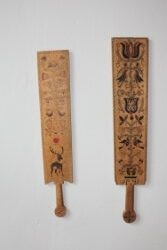Martin Mešša
In several areas of folk art, the natural talents of producers are revealed together with their talent for creating an ornament and placing it on an object. Sometimes, the ornament is an accessory for balancing the composition, such as on paintings on glass, elsewhere it fills in the empty surface of the interior of what used to be an open black kitchen once closed fireplaces and chimneys were introduced; in some places it added to part of the clothing or interior textile in the form of embroidery or a woven pattern, or else it decorated wooden furniture, tools, instruments, ceramic containers and musical instruments. Ornaments could also be an important element in the ornamentation of a work tool which also fulfilled a socio-cultural function under specifically defined conditions. This was also the case for traditional love tokens.
The producers who made them all faced the same questions: whether to choose plant or figural motifs, deciding on their size, direction, relation to the other motifs, and placing them all within a set area to make sure the whole item looked harmonious while also putting across the inner message hidden behind the chosen signs and symbols both individually and together. In time, many of the meanings of the signs disappeared from the minds not only of the artists, but of the whole of society, only to be replaced by simplified explanations based on folk songs and folklore. Nevertheless, the motifs and combinations of ornamental elements continue to have common folk culture elements and can tell us much about the artists, their community and their ideas. For this reason, it is important to be able to read the messages coded in what appear to be simply ornamental elements and to understand them.
